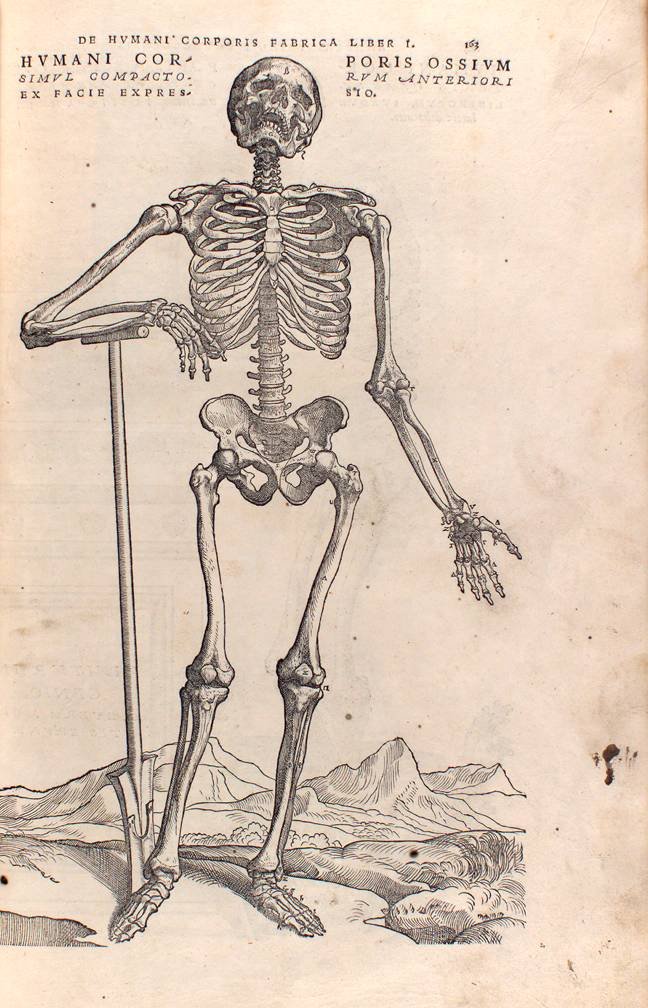Johannes Oporinus to the Rescue: The Invaluable Partnership that Changed the History of Medicine
The publishing industry has changed dramatically in the last few decades. With the onset of digitally printing, the expansion of audio books, and the ubiquity of the internet, publishing is accessible to more people than ever before. A book can be written and distributed worldwide from the confines of any home, apartment, or office. Authors can even do events and access their audience from their computer screens. But publishing wasn’t always this accessible. Just ask Andreas Vesalius and Johannes Oporinus, the author and printer, respectively, of the groundbreaking medical text De humani corpois fabrica.
In 1542, when Andreas Vesalius was looking for a publisher for his book on human anatomy, Venice was the publishing center of Europe. It was also close to Padua, the city where Vesalius was an anatomy professor for a number of years. But in Vesalius’ mind, the advantages of publishing in Venice did not outweigh its disadvantages. First, there was the challenge of geography, something modern publishers don’t need to consider. If Vesalius were to have his book printed in Venice, it may have been close to many academic centers like Padua, but distributing it to northern Europe would have required a dangerous and expensive trip over the Alps. Vesalius was also concerned with piracy, or plagiarism. This, perhaps, is not so different from today. In 1538 Vesalius published a book called Tabulae anatomicae, an anatomy textbook that was the precursor to his seminal work. Just three years after its first printing, woodcuts from the Tabulae were published in five cities across the Holy Roman Empire. Vesalius was not credited for the reprints and received no revenue from their sales. His final concern was that of censorship. In the early sixteenth century publishing had come under increased scrutiny, meaning stringent laws and regulations were passed. If Vesalius were to have his book printed in Venice, it would be subject to this scrutiny and censorship.
Introducing Johannes Oporinus, the solution to Vesalius’ dilemma. Oporinus began his career as an aspiring physician but later entered academia as a professor of Greek and Latin. In 1536 he entered into a partnership with several other printers and began seeking manuscripts to publish from the professors he had met at the University. It was during this time that Oporinus worked with Vesalius on the printing of his doctoral thesis. Then, in 1542, he left academia and the printing partnership behind to begin his own printing house in Basel, Switzerland. His first book was the first-ever printing of the Quran in Latin for which he was briefly imprisoned. The second book he printed was De humani corporis fabrica. Throughout his printing career Oporinus maintained a high reputation for scrupulous, scholarly editing, and he became known for publishing good books rather than simply being a businessman aiming for high profits. Because of that, his printing shop grew to be one of the largest in Basel, with six presses and a workforce of about thirty. Unfortunately, Oporinus’ niche of high-quality academic works was not profitable, and when he died he was deeply in debt.
Having already worked together on Vesalius’ thesis it seemed only natural that the two work together again—the pairing had several other advantages, too. To begin, Oporinus’ high standards were equal to Vesalius’ valuable, ground-breaking text. Also, Basel was a central location where it could be edited by scholars and then quickly and easily be distributed to cities like Strasbourg, Frankfurt, and Cologne. Furthermore, printing in Basel meant avoiding the censorship of Venice along with any slowdowns that came with it. By printing the book in a central location and avoiding censorship, the book could be distributed quickly which would limit piracy and therefore increase Vesalius’ influence and profits.
But there was still one more problem—getting Vesalius’ woodcuts over the Alps. Perhaps the most important element of De humani corporis fabrica were the illustrations. With more than two hundred woodcuts displaying intricate, never-before-seen details of the human skeletal and muscular systems, the artwork was paramount. For this, Vesalius had to rely on the expert draftsmanship of the block cutters in Venice. Using pearwood blocks, they recreated the drawings of Jan van Calcar, Vesalius’ illustrator, in intricate detail. Then, under his own expense and supervision, Vesalius shipped the blocks over Gotthard Pass on muleback, a journey of several weeks with the constant possibility of damage. But for Vesalius, the journey was worth it.
Andreas Vesalius assumed that his book on human anatomy would bring him fame, income, and a lasting legacy. His assumptions were right, but it wouldn’t have happened if he didn’t insist on using the right people under the right circumstances. With the perfect location, a trusted, dedicated printer, and the best illustrations possible, Andreas Vesalius and Johannes Oporinus created a book that changed the history of medicine and influenced everything we know today.
Sources:
“Johannes Oporinus,” Wikipedia, Accessed October 23, 2021, Last Updated May 26, 2021, https://en.wikipedia.org/wiki/Johannes_Oporinus
Dr. Ueli Dill, “Johannes Oporinus, Dedicated Printer of the Original Fabrica,” Karger Medical and Scientific Publishers, Accessed October 23, 2021, https://www.vesaliusfabrica.com/en/vesalius/history-context/the-printer-oporinus.html
Harry Clark, “Foiling the Pirates: The Preparation and Publication of Andreas Vesalius’s De Humani Corporis Fabrica,” Library Quarterly, Vol. 51, Issue 3, P. 301 – 311.
Want to Know More?
Read The King’s Anatomist: The Journey of Andreas Vesalius.
In 1565 Brussels, the reclusive mathematician Jan van den Bossche receives shattering news that his lifelong friend, the renowned and controversial anatomist Andreas Vesalius, has died on the Greek island of Zante returning from a pilgrimage to the Holy Land. Jan decides to journey to his friend’s grave to offer his last goodbye.



